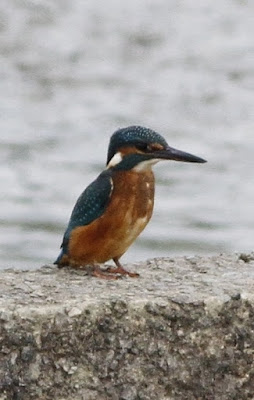Brown . DH , with all the paddocks having been cut , produced just12 from 3 species , along with 15
Large White larvae that were doing their best to demolish the brassicas in the walled garden . With the season coming to an end , these will feed up and over-winter as chrysalis , appearing as adults
next Spring .Only other interest found was a Shaggy Parasol / Lepiota rhacodes , in the Sandwalk
Beech tree outside the car park at HE .
With the promise of a dry day on Wednesday , I headed for Reculver , mainly to try and catch up with the late emerging Willow Emerald Damselfly , but on arrival found myself drawn to the areas of
Everlasting Pea / Lathyrus latifolius , the foodplant of the migrant Long-tailed Blue butterfly . I had read that the odd one or two had been seen in Sussex recently , and hoped that I might find one here . Three hours later , having scoured every pea flower in the area , I gave up , not having even had a glimpse of my hoped for rarity , the wind , blowing in off the sea didn't help . The only butterflies
seen were a dozen or so Small White , a single Peacock and Comma and two Large White . A lone
male Migrant Hawker was found warming up in the sun , whilst the Common Toadflax was still
trying to shake off it's morning dew . Disappointed , I moved on to the other side of the Thanet way to search for thr Willow Emerald Damselfly . If anything , the wind was even stronger here , but it
was also a bit warmer . The North Stream only turned up a female Migrant Hawker , so I started searching the overhanging Willows and the roadside hedges , where the Ivy flowers were busy with lots of Common Wasps , various Hoverflies , but dominated by the recently colonizers from Europe ,
the Ivy Bee / Colletes hedera , with it's ginger thorax and strikingly striped abdomen . They were first
found along the south coast some 20 years ago , but have now spread well above the Thames valley from what I have read . Eventually it was back to the overhanging Willows on the North Stream and
after a bit more searching , found my first of 3/4 WEDs . With the wind , they were tending to stay
close to the ground , making them not very easy to photograph . One individual did try to help though
, when it landed on my hand . Before leaving the area , I returned to the towers and walked out to Coldharbour and back in pleasant conditions . The tide was just on the turn back out again , but birds were definitely at a premium . Half way down , I met a birder on his way back to the car park , and he said nothing to raise my hopes of a find . A small flock of Meadow Pipit danced on the shingle and
the sea wall in front of me , one posing momentarily , a couple of Stonechat , always keepng just out of camera range , a flock of Goldfinch , plundering the seedheads and two Wheatear , one caught in
the split second between landing and immediately taking off again . Most plants along the way had gone to seed , but a couple of Yellow-horned Poppy / Glaucium flavum , had single flowers and their
long seed pods from which the 'horned' part of their name comes from . Apart from that , it was the expected species , and no sighting of the hoped for Black Redstart .
This morning I did what will be the last full transects at HE and DH . The latter produced just 4 Meadow Brown and 2 Speckled Wood , and a brief sighting of a female Roe Deer . HE went one
better with 4 Meadow Brown , 3 Speckled Wood and a single Holly Blue , a female , faded , but still
good to see . The only surprise was 10/15 Hornets , mostly near the golf car park and a couple in the
bottom glade . This one posed head on and threatening , but was more interested in warming up than bothering with me .
This afternoon , making the most of the weather , I headed up onto the Greensand Ridge looking for
any sign of breeding . The only Adders found were this male , and a year old female , probably born
about this time last year . No neonates were found on the visit , all in all , I don't think this was a good breeding season up on the Ridge .








































































